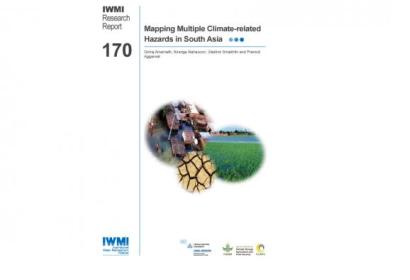Countries experience multiple climate-related risks that vary spatially and in time, with the combined impact of such risks carrying severe consequences for the population. A new collaborative research study by the International Water Management Institute (IWMI), the United Nations University Institute for Water, Environment and Health (UNU-INWEH) and the CGIAR Research Program on Climate Change Agriculture and Food Security (CCAFS) identifies the need to carry out regional level assessments of these risks in South Asia. The IWMI Research Report 170 suggests methods for mapping such climate-related risks and estimating their subsequent impacts. Space-based information is a key component in this context and supports efforts to estimate the impact on people and agriculture in South Asia. Regional, national and sub-national assessments of five related risks - floods, droughts, extreme rainfall, extreme temperature and sea-level rise, were carried out in the region. The Intergovernmental Panel on Climate Change (IPCC) vulnerability assessment framework approach was used for the study, by overlaying hazard exposure and adaptive capacity maps in order to identify areas susceptible to extreme risk. The study aims to: - develop approaches for high-spatial-resolution mapping of areas exposed to several climate-related hazards: floods, droughts, extreme rainfall, extreme temperature and sea-level rise; - develop a method for estimating the exposure of a population to individual natural hazards and their impacts on agriculture; and - assess the overall vulnerability and risk at the country level based on country-wide, urban and rural population exposure to the five hazards above. Remote sensing images were used for the different hazard assessments, which were carried out at different spatial and temporal scales. Moderate Resolution Imaging Spectroradiometer (MODIS) data with 500 m and 5,000 m resolution, made available from NASA, was used for hazard mapping. Global Land Cover data from the European Space Agency (ESA) was used to determine the vulnerability and possible impact of the five climate-related hazards considered in the study. Combining all the individual hazard-specific assessments into the Geographic Information System (GIS) environment produced maps indicating areas that were most vulnerable to specific hazards, and the overall impact of the multi-hazards. The vulnerability, exposure and overall impact maps produced from the research could help inform decision makers on financial aid distribution and how to allocate resources within the country. Additionally, a comparison can also be made within the country and between countries to encourage to share best practices, adaptation and mitigation measures. The model is designed to be flexible, allowing exposure assessment methods to be applied to a range of outcomes and adaptation strategies. IWMI is a UN-SPIDER Regional Support Office (RSO). The report can be downloaded at: http://www.iwmi.cgiar.org/publications/iwmi-research-reports/iwmi-research-report-170/

